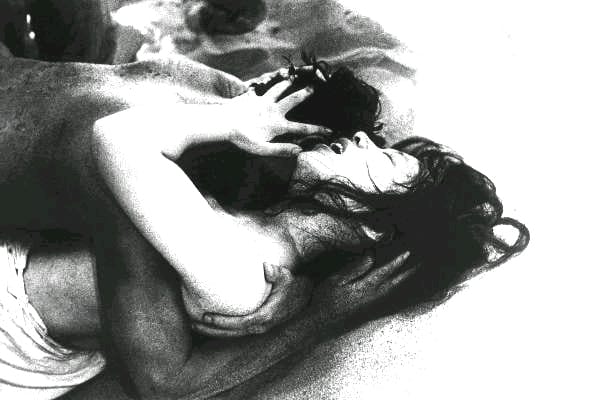An amateur entomologist searching for insects by the sea is trapped by local villagers into living with a mysterious woman who spends almost all her time preventing her home from being swallowed up by advancing sand dunes.
Eiji Okada: Entomologist Niki Jumpei
Kyôko Kishida: Woman
Woman in the Dunes (砂の女, Suna no onna?, literally "Sand woman," also translated as Woman of the Dunes) is a novel by Kōbō Abe and a film based on the novel, directed by Hiroshi Teshigahara. The novel was published in 1962, and the film was released in 1964. Kōbō Abe also wrote the screenplay for the film version.

The surreal and artistic natures which reside within Woman in the Dunes has been compared to existentialist works such as Sartre's No Exit and Beckett's Happy Days. Aside from its intriguing premise, this film is notable for the life that Teshigahara brings to the ever-shifting sand, which almost becomes a character in its own right.
There is an almost magical, timeless quality presiding over the whole affair, from start to finish. Entomologist Niki Jumpei, the insect collecting protagonist becomes the vocal point, and prisoner, for the bizarre peoples living in the dunes.
The insect collecting transported me back to my younger days where I would collect insects of my own, especially Elephant Hawk Moths and the metamorphose stage. His character in this film in a way is sort of a cocoon too as he changes with his imprisonment; Niki captures insects,The Villagers capture him.
Every grain of sand invades our minds as well as the characters it constantly tries to drown. Woman in the Dunes myriad of possibility stems from the reality regarding our existence, being one defined with confinement and imprisonment.
This reality would appear to be the epitome upon which Director Hiroshi Teshigahara scratches his creative nails into. The realisation that the cages aspiring to our everyday lives are in fact hidden by the illusion they're not. The sands, the dunes are the representation of time itself. Inescapable, inexcusable, relentless and always we are fighting against it burying us; Just like the Man and Woman trapped in the Dunes by the villagers. This is a symbiotic relation upon which the ''couple'' are needed by the villagers and vice versa.
''It's useless. The sand can swallow up cities and countries, if it wants to.''
The later segments that Woman in the Dunes conveys across to us are ones which address mortality and acceptance. The Man at this point has tried to escape yet is re-captured by the villagers simply because the sandy wilderness is just as inescapable as the Dune he leaves.
The sexual desires fulfilled begin to be an after thought cooked up by the Villagers; Desires blossom into complacency and the desire to escape dies out like the exhausting of a candle.
Kôbô Abe's novel is beautifully captured, while his screenplay elevates the questions and mystery to the complex yet simple storytelling. The discussions and explanations for Woman in the Dunes is certainly infinite bestowing wisdom and higher thought upon audiences and film makers alike. The blue print for existential revelations has come forward in many projects after this mesmerising example of not just art but depth following ambiguity.
The focus of the film shifts to the way in which the couple cope with the oppressiveness of their condition and the power of their physical attraction in spite of — or possibly because of — their situation.
Niki finds new ways to occupy his time and adapt himself to this isolated lifestyle, in essence perhaps brain washed and moulded by his environment and captors, similar to the life he had in the city perhaps. He develops a water collecting technology from damp sand involving crows and a pot he has in the sand. This would be classed, for me, as the part where he accepts his chosen fate by these strange inhabitants whom seem to be moulding them, as they in turn mould the sand. Woman in the Dunes is one to watch over and over while always drawing inspirations from it's storytelling, cinematography with sweeping landscapes, and the living Sand which is another being and character in it's own right. This is a stroke of genius and a firmly established favourite of mine from the first viewing to the tenth, it remains infinitely as rewarding.
''...Men and women are slaves to their fear of being cheated. In turn they dream up new certificates to prove their innocence...''
10/10
 Login
Login